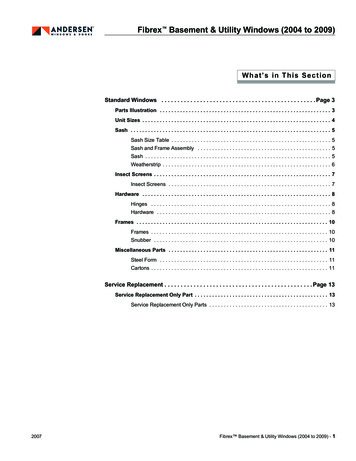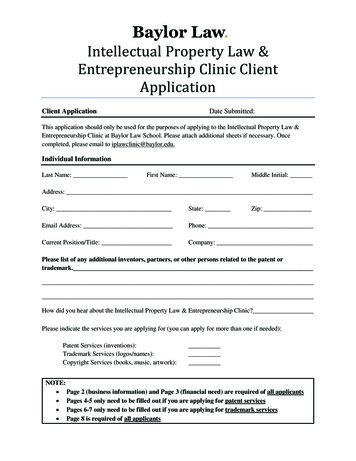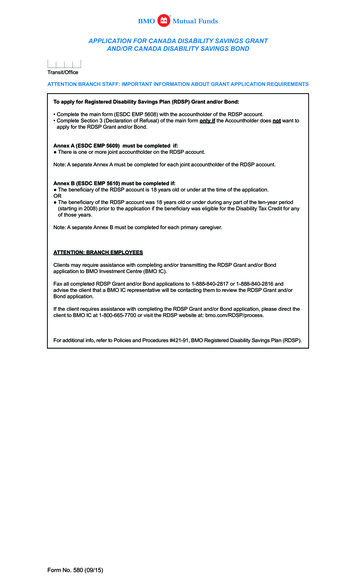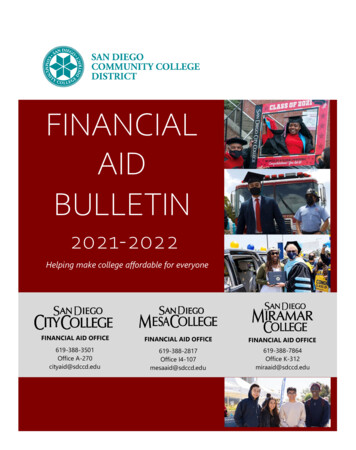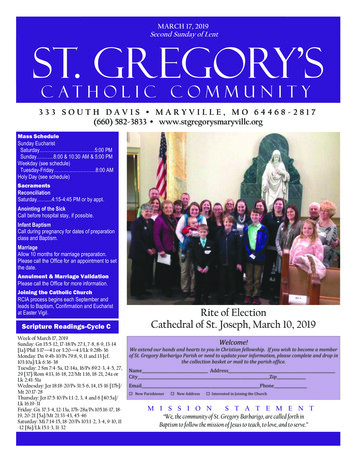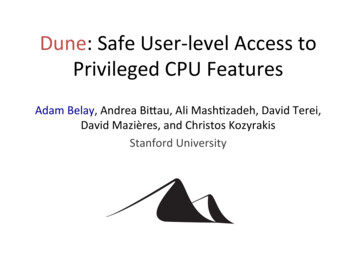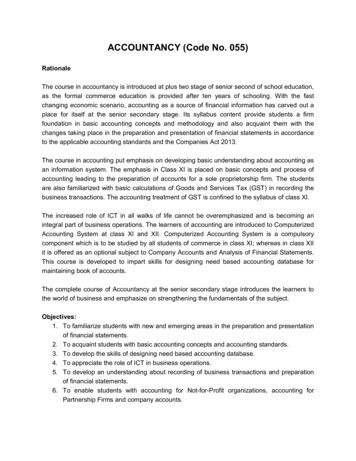
Transcription
ACCOUNTANCY (Code No. 055)RationaleThe course in accountancy is introduced at plus two stage of senior second of school education,as the formal commerce education is provided after ten years of schooling. With the fastchanging economic scenario, accounting as a source of financial information has carved out aplace for itself at the senior secondary stage. Its syllabus content provide students a firmfoundation in basic accounting concepts and methodology and also acquaint them with thechanges taking place in the preparation and presentation of financial statements in accordanceto the applicable accounting standards and the Companies Act 2013.The course in accounting put emphasis on developing basic understanding about accounting asan information system. The emphasis in Class XI is placed on basic concepts and process ofaccounting leading to the preparation of accounts for a sole proprietorship firm. The studentsare also familiarized with basic calculations of Goods and Services Tax (GST) in recording thebusiness transactions. The accounting treatment of GST is confined to the syllabus of class XI.The increased role of ICT in all walks of life cannot be overemphasized and is becoming anintegral part of business operations. The learners of accounting are introduced to ComputerizedAccounting System at class XI and XII. Computerized Accounting System is a compulsorycomponent which is to be studied by all students of commerce in class XI; whereas in class XIIit is offered as an optional subject to Company Accounts and Analysis of Financial Statements.This course is developed to impart skills for designing need based accounting database formaintaining book of accounts.The complete course of Accountancy at the senior secondary stage introduces the learners tothe world of business and emphasize on strengthening the fundamentals of the subject.Objectives:1. To familiarize students with new and emerging areas in the preparation and presentationof financial statements.2. To acquaint students with basic accounting concepts and accounting standards.3. To develop the skills of designing need based accounting database.4. To appreciate the role of ICT in business operations.5. To develop an understanding about recording of business transactions and preparationof financial statements.6. To enable students with accounting for Not-for-Profit organizations, accounting forPartnership Firms and company accounts.
Accountancy (Code No.055)Course StructureClass-XI (2022-23)Theory: 80 Marks3 HoursProject: 20 MarksUnitsPeriodsMarksUnit-1: Theoretical Framework2512Unit-2: Accounting Process1154460242020Part A: Financial Accounting-1Part B: Financial Accounting-IIUnit-3: Financial Statements of Sole ProprietorshipPart C: Project WorkPART A: FINANCIAL ACCOUNTING - IUnit-1: Theoretical Frame WorkUnits/TopicsLearning OutcomesIntroduction to AccountingAfter going through this Unit, the students will be Accounting- concept, meaning, as a sourceof information, objectives, advantages and describe the meaning, significance,limitations, types of accounting information;objectives, advantages and limitations ofusers of accounting information and theiraccounting in the modem economicneeds. Qualitative Characteristics ofenvironment with varied types of businessAccounting Information. Role of Accounting inand non-business economic entities.Business. able to: identify / recognise the individual(s) andBasic Accounting Terms- Entity, Businessentities that use accounting information forTransaction, Capital, Drawings. Liabilitiesserving their needs of decision making.(Non Current and Current). Assets (Non explain the various terms used in accountingCurrent, Current); Expenditure (Capital andand differentiate between different relatedRevenue), Expense, Revenue, Income,terms like current and non-current, capitalProfit, Gain, Loss, Purchase, Sales, Goods,and revenue.Stock, Debtor, Creditor, Voucher, Discount (Trade discount and Cash Discount)give examples of terms like businesstransaction, liabilities, assets, expenditureand purchases.Theory Base of Accounting explain that sales/purchases include bothFundamental accounting assumptions:cash and credit sales/purchases relating toGAAP: Conceptthe accounting year.Basic accounting concept : Business Entity,
Money Measurement, Going Concern, differentiate among income, profits and gains.Accounting Period, Cost Concept, Dual state the meaning of fundamental accountingAspect, Revenue Recognition, Matching, Fullassumptions and their relevance inDisclosure, Consistency, Conservatism,accounting.Materiality and Objectivity describe the meaning of accountingSystem of Accounting. Basis of Accounting:assumptions and the situation in which ancash basis and accrual basisassumption is applied during the accounting Accounting Standards: Applicability in IndASprocess. Goods and Services Tax (GST): Characteristics and Advantages.explain the meaning, applicability, objectives,advantages and limitations of accountingstandards. appreciate that various accounting standardsdeveloped nationally and globally are inpractice for bringing parity in the accountingtreatment of different items. acknowledge the fact that recording ofaccounting transactions follows double entrysystem. explain the bases of recording accountingtransaction and to appreciate that accrualbasis is a better basis for depicting thecorrect financial position of an enterprise. Explain the meaning, advantages andcharacteristic of GST.Unit-2: Accounting ProcessUnits/TopicsLearning OutcomesRecording of Business TransactionsAfter going through this Unit, the students will be Voucher and Transactions: Sourcedocuments and Vouchers, Preparation of able to: explain the concept of accounting equationVouchers, Accounting Equation Approach:and appreciate that every transaction affectsMeaning and Analysis, Rules of Debit andeither both the sides of the equation or aCredit.positive effect on one item and a negativeRecording of Transactions: Books of Originaleffect on another item on the same side ofEntry- Journalaccounting equation. Special Purpose books: Cash Book: Simple, cash book with bankdecrease) on the assets, liabilities, capital,column and petty cashbookrevenue and expenses. explain the effect of a transaction (increase or
Purchases book Sales bookdocuments, accounting vouchers are Purchases return bookprepared for recording transaction in the Sales return bookbooks of accounts. Journal proper appreciate that on the basis of sourcedevelop the understanding of recording ofNote: Including trade discount, freight and cartagetransactions in journal and the skill ofexpenses for simple GST calculation.calculating GST. Ledger: Format, Posting from journal and explain the purpose of maintaining a CashBook and develop the skill of preparing thesubsidiary books, Balancing of accountsformat of different types of cash books andBank Reconciliation Statement: the method of recording cash transactions inNeed and preparation, Bank ReconciliationStatementCash book. Depreciation, Provisions and Reserves Amortisationbank balance as shown by the pass book /Methods of Depreciation:bank statement and to reconcile both thei. Straight Line Method (SLM)balances, bank reconciliation statement isii. Written Down Value Method (WDV)prepared. Difference between SLM and WDV; Method of recoding depreciationfrom subsidiary books and journal proper intothe concerned accounts in the ledger anddepreciation/accumulated depreciation Treatment of disposal of asset Provisions, Reserves, Difference BetweenProvisions and Reserves.Types of Reserves:i. Revenue reserveii. Capital reserveiii. General reserveiv. Specific reservev. Secret Reserve appreciate that for ascertaining the position ofindividual accounts, transactions are postedii. Creating provision foraccountdevelop understanding of preparing bankreconciliation statement.i. Charging to asset account appreciate that at times bank balance asindicated by cash book is different from theAdvantages of SLM and WDV per their nature in different subsidiary books .Other similar terms: Depletion andNote: Excluding change of method transactions other than cash transactions asDepreciation: Meaning, Features, Need,Causes, factorsdescribe the method of recordingdevelop the skill of ledger posting. explain the necessity of providingdepreciation and develop the skill of usingdifferent methods for computing depreciation. understand the accounting treatment ofproviding depreciation directly to theconcerned asset account or by creatingprovision for depreciation account. appreciate the method of asset disposalDifference between capital and revenuethrough the concerned asset account or byreservepreparing asset disposal account. appreciate the need for creating reserves and
Trial balance and Rectification of Errors Trial balance: objectives, meaning andbelong to the current year but may happen inpreparationnext year.(Scope: Trial balance with balance method only) Errors: classification-errors of omission,commission, principles, and compensating; also making provisions for events which mayand reserve fund. state the need and objectives of preparingtheir effect on Trial Balance.trial balance and develop the skill ofDetection and rectification of errors;preparing trial balance.(i)Errors which do not affect trial balance (ii) Errors which affect trial balance appreciate the difference between reservepreparation of suspense account.appreciate that errors may be committedduring the process of accounting. understand the meaning of different types oferrors and their effect on trial balance. develop the skill of identification and locationof errors and their rectification andpreparation of suspense account.Part B: Financial Accounting - IIUnit 3: Financial Statements of Sole ProprietorshipUnits/TopicsLearning OutcomesFinancial StatementsAfter going through this Unit, the students will beMeaning, objectives and importance; Revenue andable to:Capital Receipts; Revenue and Capital Expenditure; state the meaning of financial statements theDeferred Revenue expenditure. Opening journal purpose of preparing financial statements.entry. Trading and Profit and Loss Account: Gross Balance Sheet: need, grouping and marshalling of state the meaning of gross profit, operatingprofit and net profit and develop the skill ofpreparing trading and profit and loss account.explain the need for preparing balance sheet.assets and liabilities. Preparation. Adjustments in understand the technique of grouping andProfit, Operating profit and Net profit. Preparation.preparation of financial statements with respect toclosing stock, outstanding expenses, prepaidmarshalling of assets and liabilities. appreciate that there may be certain itemsexpenses, accrued income, income received inother than those shown in trial balance whichadvance, depreciation, bad debts, provision formay need adjustments while preparingdoubtful debts, provision for discount on debtors,financial statements.Abnormal loss, Goods taken for personal use/staff develop the understanding and skill to dowelfare, interest on capital and managersadjustments for items and their presentationcommission. Preparation of Trading and Profit andin financial statements like depreciation,Loss account and Balance Sheet of a soleclosing stock, provisions, abnormal loss etc.proprietorship with adjustments. develop the skill of preparation of trading andprofit and loss account and balance sheet.
Part C: Project Work (Any One)1. Collection of source documents, preparation of vouchers, recording of transactions with the help of vouchers.2. Preparation of Bank Reconciliation Statement with the given cash book and the pass book with twenty totwenty-five transactions.3. Comprehensive project of any sole proprietorship business. This may state with journal entries and theirledgering, preparation of Trial balance. Trading and Profit and Loss Account and Balance Sheet. Expenses,incomes and profit (loss), assets and liabilities are to be depicted using pie chart / bar diagram.
PROJECT WORKIt is suggested to undertake this project after completing the unit on preparation of financial statements. Thestudent(s) will be allowed to select any business of their choice or develop the transaction of imaginarybusiness. The project is to run through the chapters and make the project an interesting process. The amountsshould emerge as more realistic and closer to reality.Specific Guidelines for TeachersGive a list of options to the students to select a business form. You can add to the given list:1. A beauty parlour2. Men's saloon3. A tailoring shop4. A canteen5. A cake shop6. A confectionery shop7. A chocolate shop8. A dry cleaner9. A stationery shop10. Men's wear11. Ladies wear12. Kiddies wear13. A Saree shop14. Artificial jewellery shop15. A small restaurant16. A sweet shop17. A grocery shop18. A shoe shop19. A coffee shop20. A music shop21. A juice shop22. A school canteen23. An ice cream parlour24. A sandwich shop25. A flower shopAfter selection, advise the student(s) to visit a shop in the locality (this will help them to settle on a realisticamounts different items. The student(s) would be able to see the things as they need to invest in furniture,decor, lights, machines, computers etc.A suggested list of different item is given below.1. Rent2. Advance rent [approximately three months]3. Electricity deposit4. Electricity bill5. Electricity fitting6. Water bill7. Water connection security deposit8. Water fittings9. Telephone bill10. Telephone security deposit11. Telephone instrument12. Furniture13. Computers14. Internet connection15. Stationery16. Advertisements17. Glow sign18. Rates and Taxes19. Wages and Salary20. Newspaper and magazines21. Petty expenses22. Tea expenses23. Packaging expenses24. Transport25. Delivery cycle or a vehicle purchased26. Registration27. Insurance28. Auditors fee29. Repairs & Maintenance30. Depreciations31. Air conditioners32. Fans and lights33. Interior decorations34. Refrigerators35. Purchase and salesAt this stage, performas of bulk of originality and ledger may be provided to the students and they may beasked to complete the same.In the next step the students are expected to prepare the trial balance and the financial statements.
Suggested Question Paper DesignAccountancy (Code No. 055)Class XI (2022-23)Theory: 80 MarksProject: 20 MarksSN1343 hrs.Typology of QuestionsRemembering and Understanding:Exhibit memory of previously learned material by recalling facts, terms, basic concepts,and answers.Demonstrate understanding of facts and ideas by organizing, comparing, translating,interpreting, giving descriptions, and stating main ideasApplying: Solve problems to new situations by applying acquired knowledge, facts,techniques and rules in a different way.Analysing, Evaluating and Creating:Examine and break information into parts by identifying motives or causes. Makeinferences and find evidence to support generalizations.Present and defend opinions by making judgments about information, validity of ideas, orquality of work based on a set of criteria.Compile information together in a different way by combining elements in a new patternor proposing alternative %80100%
Accountancy (Code No. 055)Class-XII (2022-23)Theory: 80 Marks3 HoursProject: 20 MarksUnitsPart APart BPart CPeriodsMarksUnit 1. Accounting for Partnership Firms10536Unit 2. Accounting for Companies452415060Unit 3. Analysis of Financial Statements3012Unit 4. Cash Flow Statement20850202020Unit 4. Computerized Accounting5020Practical Work2020Accounting for Partnership Firms and CompaniesFinancial Statement AnalysisProject WorkProject work will include:Project File4 MarksWritten Test12 Marks (One Hour)Viva Voce4 MarksOrPart BPart CComputerized AccountingPractical work will include:Practical File 4 MarksPractical Examination 12 Marks (One Hour)Viva Voce 4 Marks
Part A: Accounting for Partnership Firms and CompaniesUnit 1: Accounting for Partnership FirmsUnits/TopicsLearning Outcomes Partnership: features, Partnership Deed.After going through this Unit, the students will be Provisions of the Indian Partnership Act 1932able to:in the absence of partnership deed. state the meaning of partnership, partnershipfirm and partnership deed.Fixed v/s fluctuating capital accounts.Preparation of Profit and Loss Appropriation describe the characteristic features ofaccount- division of profit among partners,partnership and the contents of partnershipguarantee of profits.deed.Past adjustments (relating to interest on discuss the significance of provision ofcapital, interest on drawing, salary and profitPartnership Act in the absence of partnershipsharing ratio).deed.Goodwill: meaning, nature, factors affecting differentiate between fixed and fluctuatingand methods of valuation - average profit,capital, outline the process and develop thesuper profit and capitalization.understanding and skill of preparation ofProfit and Loss Appropriation Account.Note: Interest on partner's loan is to be treated as a develop the understanding and skill ofcharge against profits.preparation profit and loss appropriationGoodwill: meaning, factors affecting, need foraccount involving guarantee of profits.valuation, methods for calculation (average profits, super profits and capitalization) , adjusted throughpartners capital/ current account or by raising andmaking past adjustments. writing off goodwill (AS 26) develop the understanding and skill ofvaluation of goodwill using different methods. state the meaning of sacrificing ratio, gainingChange in the Profit Sharing Ratio amongratio and the change in profit sharing ratiothe existing partners - sacrificing ratio,among existing partners.gaining ratio, accounting for revaluation of state the meaning, nature and factors affectingoodwillAccounting for Partnership firms - Reconstitutionand Dissolution.develop the understanding and skill of develop the understanding of accountingassets and reassessment of liabilities andtreatment of revaluation assets andtreatment of reserves, accumulated profitsreassessment of liabilities and treatment ofand losses. Preparation of revaluationreserves and accumulated profits byaccount and balance sheet.preparing revaluation account and balanceAdmission of a partner - effect of admissionsheet.of a partner on change in the profit sharing ratio, treatment of goodwill (as per AS 26),treatment for revaluation of assets and reassessment of liabilities, treatment ofexplain the effect of change in profit sharingratio on admission of a new partner. develop the understanding and skill of
reserves, accumulated profits and losses,treatment of goodwill as per AS-26, treatmentadjustment of capital accounts andof revaluation of assets and re-assessment ofpreparation of capital, current account andliabilities, treatment of reserves andbalance sheet.accumulated profits, adjustment of capitalRetirement and death of a partner: effect ofaccounts and preparation of capital, currentretirement / death of a partner on change inaccount and balance sheet of the new firm.profit sharing ratio, treatment of goodwill (as per AS 26), treatment for revaluation ofassets and reassessment of liabilities, explain the effect of retirement / death of apartner on change in profit sharing ratio. develop the understanding of accountingadjustment of accumulated profits, lossestreatment of goodwill, revaluation of assetsand reserves, adjustment of capital accountsand re-assessment of liabilities andand preparation of capital, current accountadjustment of accumulated profits, lossesand balance sheet. Preparation of loanand reserves on retirement / death of aaccount of the retiring partner.partner and capital adjustment.Calculation of deceased partner’s share of develop the skill of calculation of deceasedprofit till the date of death. Preparation ofpartner's share till the time of his death anddeceased partner’s capital account and hisprepare deceased partner's and executor'sexecutor’s account.account.Dissolution of a partnership firm: meaning discuss the preparation of the capitalof dissolution of partnership and partnershipaccounts of the remaining partners and thefirm, types of dissolution of a firm. Settlementbalance sheet of the firm after retirement /of accounts - preparation of realizationdeath of a partner.account, and other related accounts: capital accounts of partners and cash/bank a/c(excluding piecemeal distribution, sale to aunderstand the situations under which apartnership firm can be dissolved. company and insolvency of partner(s)).develop the understanding of preparation ofrealisation account and other relatedNote:accounts.(i) If the realized value of tangible assets is not given itshould be considered as realized at book value itself.(ii) If the realized value of intangible assets is notgiven it should be considered as nil (zero value).(ii) In case, the realization expenses are borne by apartner, clear indication should be given regarding thepayment thereof.Unit-3 Accounting for CompaniesUnits/TopicsLearning OutcomesAccounting for Share CapitalAfter going through this Unit, the students will be Features and types of companiesable to:
Share and share capital: nature and types. Accounting for share capital: issue andand differentiate between equity shares andallotment of equity and preferences shares.preference shares and different types ofPublic subscription of shares - overshare capital.subscription and under subscription of shares; issue at par and at premium, calls inadvance and arrears (excluding interest), understand the meaning of private placementof shares and Employee Stock Option Plan. explain the accounting treatment of shareissue of shares for consideration other thancapital transactions regarding issue ofcash.shares.Concept of Private Placement and Employee develop the understanding of accountingStock Option Plan (ESOP), Sweat Equity.treatment of forfeiture and re-issue ofAccounting treatment of forfeiture and re-forfeited shares.issue of shares. state the meaning of share and share capital describe the presentation of share capital inDisclosure of share capital in the Balancethe balance sheet of the company as perSheet of a company.schedule III part I of the Companies Act2013.Accounting for Debentures explain the accounting treatment of differentDebentures: Meaning, types, Issue ofcategories of transactions related to issue ofdebentures at par, at a premium and at adebentures.discount. Issue of debentures for consideration other than cash; Issue ofdebentures with terms of redemption;of discount / loss on issue of debentures. debentures as collateral security-concept,interest on debentures. Writing off discount /develop the understanding and skill of writingunderstand the concept of collateral securityand its presentation in balance sheet. loss on issue of debentures.develop the skill of calculating interest ondebentures and its accounting treatment. Note: Discount or loss on issue of debentures to bestate the meaning of redemption ofdebentures.written off in the year debentures are allotted fromSecurity Premium Reserve (if it exists) and then fromStatement of Profit and Loss as Financial Cost (AS16)Part B: Financial Statement AnalysisUnit 4: Analysis of Financial StatementsUnits/TopicsLearning OutcomesFinancial statements of a Company:After going through this Unit, the students will beMeaning, Nature, Uses and importance of financialable to:Statement. develop the understanding of major headings
Statement of Profit and Loss and Balance Sheet inand sub-headings (as per Schedule III to theprescribed form with major headings and subCompanies Act, 2013) of balance sheet asheadings (as per Schedule III to the Companies Act,per the prescribed norms / formats. 2013)state the meaning, objectives and limitationsof financial statement analysis.Note: Exceptional items, extraordinary items and profit (loss) from discontinued operations areexcluded. 'financial statements analysis'. Financial Statement Analysis: Meaning,Significance Objectives, importance and Tools for Financial Statement Analysis: current ratio and quick ratio. develop the skill of computation of debt equityratio, total asset to debt ratio, proprietary ratioAccounting Ratios: Meaning, Objectives,and interest coverage ratio. develop the skill of computation of inventoryLiquidity Ratios: Current ratio and Quickturnover ratio, trade receivables and traderatio.payables ratio and working capital turnoverSolvency Ratios: Debt to Equity Ratio, Totalratio and others.Asset to Debt Ratio, Proprietary Ratio and develop the understanding of computation ofCash flow analysis, ratio analysis.Advantages, classification and computation. state the meaning, objectives andsignificance of different types of ratios.limitations. discuss the meaning of different tools of develop the skill of computation of grossInterest Coverage Ratio. Debt to Capitalprofit ratio, operating ratio, operating profitEmployed Ratio.ratio, net profit ratio and return on investment.Activity Ratios: Inventory Turnover Ratio,Trade Receivables Turnover Ratio, TradePayables Turnover Ratio, Fixed AssetTurnover Ratio, Net Asset Turnover Ratioand Working Capital Turnover Ratio. Profitability Ratios: Gross Profit Ratio,Operating Ratio, Operating Profit Ratio, NetProfit Ratio and Return on Investment.Note: Net Profit Ratio is to be calculated on the basis of profit before and after tax.Unit 5: Cash Flow StatementUnits/Topics Learning OutcomesMeaning, objectives Benefits, Cash and CashAfter going through this Unit, the students willEquivalents, Classification of Activities andbe able to:preparation (as per AS 3 (Revised) (Indirect Method only)state the meaning and objectives of cash flowstatement. develop the understanding of preparation of
Note:Cash Flow Statement using indirect method(i) Adjustments relating to depreciation andas per AS 3 with given adjustments.amortization, profit or loss on sale of assets includinginvestments, dividend (both final and interim) and tax.(ii) Bank overdraft and cash credit to be treated asshort term borrowings.(iii) Current Investments to be taken as Marketablesecurities unless otherwise specified.Note: Previous years’ Proposed Dividend to be given effect, as prescribed in AS-4, Events occurring after theBalance Sheet date. Current years’ Proposed Dividend will be accounted for in the next year after it is declaredby the shareholders.
Project WorkNote: Kindly refer to the Guidelines published by the CBSE.The comprehensive project may contain simple GST calculations.ORPart B: Computerised AccountingUnit 4: Computerised AccountingOverview of Computerised Accounting System Introduction: Application in Accounting. Features of Computerised Accounting System. Structure of CAS. Software Packages: Generic; Specific; Tailored.Accounting Application of Electronic Spreadsheet. Concept of electronic spreadsheet. Features offered by electronic spreadsheet. Application in generating accounting information - bank reconciliation statement; asset accounting;loan repayment of loan schedule, ratio analysis Data representation- graphs, charts and diagrams.Using Computerized Accounting System. Steps in installation of CAS, codification and Hierarchy of account heads, creation of accounts. Data: Entry, validation and verification. Adjusting entries, preparation of balance sheet, profit and loss account with closing entries andopening entries. Need and security features of the system.Part C: Practical WorkPlease refer to the guidelines published by CBSE.Prescribed Books:Financial Accounting -IAccountancy -IIAccountancy -IAccountancy -IIAccountancy – Computerised Accounting SystemClass XIClass XIClass XIIClass XIIClass XIINCERT PublicationNCERT PublicationNCERT PublicationNCERT PublicationNCERT PublicationGuidelines for Project Work in Accounting and Practical work in computerised Accounting Class XII CBSEPublication
Suggested Question Paper DesignAccountancy (Code No. 055)Class XII (2022-23)Theory: 80 MarksProject: 20 MarksSN1343 hrs.Typology of QuestionsRemembering and Understanding:Exhibit memory of previously learned material by recalling facts, terms, basic concepts,and answers.Demonstrate understanding of facts and ideas by organizing, comparing, translating,interpreting, giving descriptions, and stating main ideasApplying: Solve problems to new situations by applying acquired knowledge, facts,techniques and rules in a different way.Analysing, Evaluating and Creating:Examine and break information into parts by identifying motives or causes. Makeinferences and find evidence to support generalizations.Present and defend opinions by making judgments about information, validity of ideas, orquality of work based on a set of criteria.Compile information together in a different way by combining elements in a new patternor proposing alternative %80100%
&&2817 1& &rgh 1r 5dwlrqdoh 7kh frxuvh lq dffrxqwdqf\ lv lqwurgxfhg dw soxv wzr vwdjh ri vhqlru vhfrqg ri vfkrro hgxfdwlrq dv wkh irupdo frpphufh hgxfdwlrq lv surylghg diwhu whq \hduv ri vfkrrolqj :lwk wkh idvw fkdqjlqj hfrqrplf vfhqdulr dffrxqwlqj dv d vrxufh ri ilqdqfldo lqirupdwlrq kdv fduyhg rxw d
